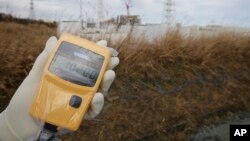GENEVA —
The World Health Organization reports the health risks for people exposed to radiation in the 2011 nuclear disaster in Fukushima, Japan are low. The nearly 200-page WHO report represents the first international global assessment of health risks from the nuclear accident following the earthquake and tsunami, which struck Fukushima on March 11, 2011.
International experts conducted the study over the past two years. The experts, chosen by the World Health Organization, looked at the potential lifetime risk of so-called solid cancers including leukemia, breast cancer and thyroid cancer.
The experts estimated risks in the general population in the highly contaminated Fukushima Prefecture, as well as inside and outside Japan. They also assessed the health risks to emergency workers who were exposed to radiation at the power plant in the immediate aftermath of the disaster.
WHO Director for Public Health and Environment, Maria Neira, says the assessment finds no discernible increase in health risks from the Fukushima event in countries outside Japan.
With respect to inside Japan, she says the lifetime risk for some cancers may be somewhat elevated above what would normally be expected during a person’s lifetime. The information was gathered in certain age and sex groups that were living in the most-affected areas.
“Those levels in the Fukushima Prefecture were too low to affect development or outcome of pregnancy and no increases as a result of anti-natal radiation exposure in a spontaneous abortion or miscarriage or perinatal mortality or congenital defects or cognitive impairments are anticipated,” said Neira.
In the most contaminated location, the report estimates the increased risks of all solid cancers, over what would normally be expected, are around four percent in females exposed as infants. It expects a six percent rise of breast cancer in females, about a seven percent increase in leukemia in males, and a rise in thyroid cancer of up to 70 percent in females exposed as infants.
The report finds around two-thirds of emergency workers are estimated to have cancer risks in line with the general population, while one-third is estimated to have an increased risk.
During the Fukushima nuclear meltdown, concerns were raised about the contamination of food and water. Acting Director for WHO’s Food Safety and Zoonosis Department, Angelika Tritscher, says these concerns persist. She says monitoring is continuous because of the long lifetime of the nuclear environment.
“The external exposure sources air and through the ground and the cloud, while this is relatively decreasing, relatively proportionally, the ingestion continues to be a concern and monitoring has to continue on this,” said Tritscher.
The WHO report does not deal with the mental or psychological impact of the Fukushima accident and its possible consequences on health and well-being. But, the experts agree these should not be ignored and people affected by the disaster should be monitored and provided with therapeutic help if needed.
International experts conducted the study over the past two years. The experts, chosen by the World Health Organization, looked at the potential lifetime risk of so-called solid cancers including leukemia, breast cancer and thyroid cancer.
The experts estimated risks in the general population in the highly contaminated Fukushima Prefecture, as well as inside and outside Japan. They also assessed the health risks to emergency workers who were exposed to radiation at the power plant in the immediate aftermath of the disaster.
WHO Director for Public Health and Environment, Maria Neira, says the assessment finds no discernible increase in health risks from the Fukushima event in countries outside Japan.
With respect to inside Japan, she says the lifetime risk for some cancers may be somewhat elevated above what would normally be expected during a person’s lifetime. The information was gathered in certain age and sex groups that were living in the most-affected areas.
“Those levels in the Fukushima Prefecture were too low to affect development or outcome of pregnancy and no increases as a result of anti-natal radiation exposure in a spontaneous abortion or miscarriage or perinatal mortality or congenital defects or cognitive impairments are anticipated,” said Neira.
In the most contaminated location, the report estimates the increased risks of all solid cancers, over what would normally be expected, are around four percent in females exposed as infants. It expects a six percent rise of breast cancer in females, about a seven percent increase in leukemia in males, and a rise in thyroid cancer of up to 70 percent in females exposed as infants.
The report finds around two-thirds of emergency workers are estimated to have cancer risks in line with the general population, while one-third is estimated to have an increased risk.
During the Fukushima nuclear meltdown, concerns were raised about the contamination of food and water. Acting Director for WHO’s Food Safety and Zoonosis Department, Angelika Tritscher, says these concerns persist. She says monitoring is continuous because of the long lifetime of the nuclear environment.
“The external exposure sources air and through the ground and the cloud, while this is relatively decreasing, relatively proportionally, the ingestion continues to be a concern and monitoring has to continue on this,” said Tritscher.
The WHO report does not deal with the mental or psychological impact of the Fukushima accident and its possible consequences on health and well-being. But, the experts agree these should not be ignored and people affected by the disaster should be monitored and provided with therapeutic help if needed.
